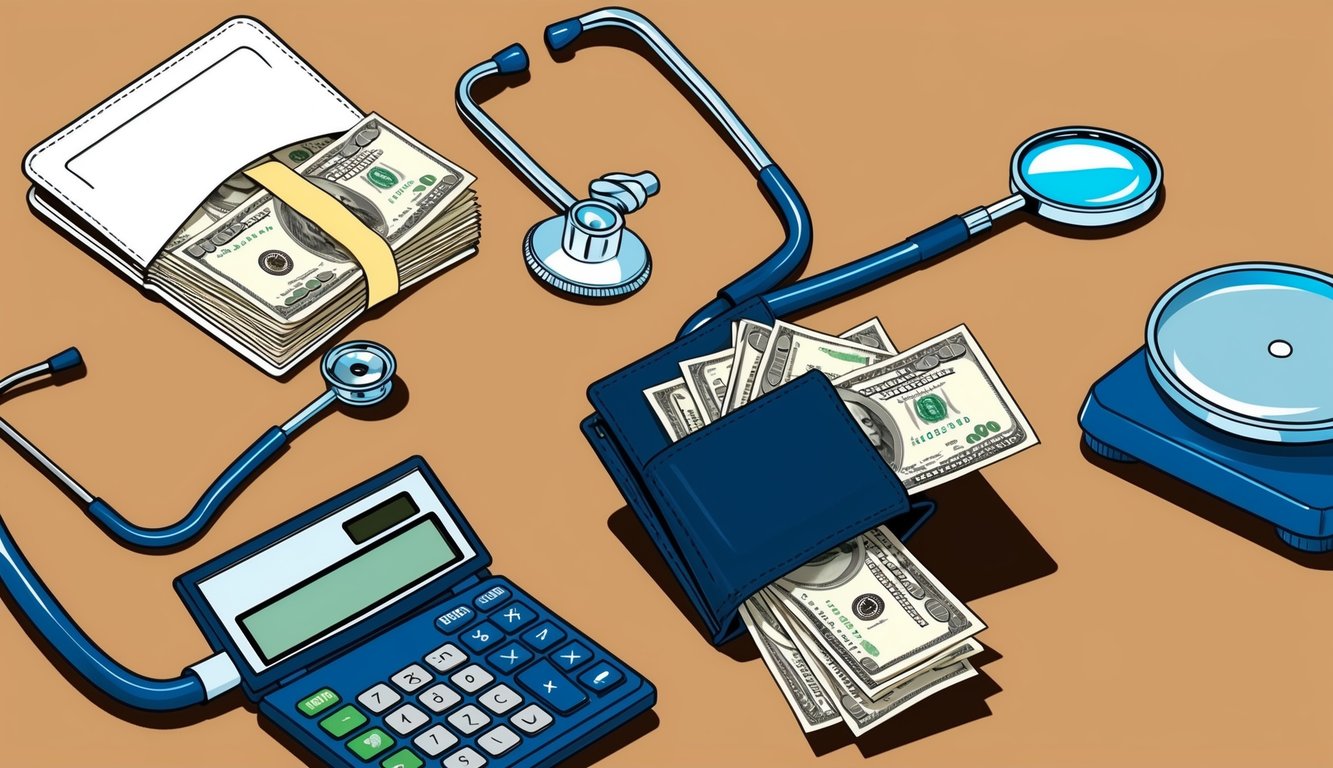Health insurance costs can be a significant burden on your budget, but there are ways to reduce your premiums without sacrificing coverage.
By understanding the factors that influence insurance rates and implementing smart strategies, you can potentially save hundreds or even thousands of dollars each year.
You have more control over your health insurance premiums than you might realize. With the right approach, you can find ways to lower your costs while still maintaining adequate protection for you and your family.
This article will explore five lesser-known techniques to help you achieve substantial savings on your health insurance premiums.
1) Choose a High-Deductible Health Plan (HDHP)

Opting for a High-Deductible Health Plan (HDHP) can significantly lower your monthly premiums.
These plans require you to pay more out-of-pocket before insurance coverage kicks in, but they offer lower monthly costs.
HDHPs typically have deductibles of at least $1,400 for individuals and $2,800 for families.
In exchange for higher deductibles, you’ll enjoy lower monthly premiums compared to traditional health plans.
One major advantage of HDHPs is the ability to pair them with a Health Savings Account (HSA).
An HSA allows you to set aside pre-tax dollars for medical expenses, helping you save money on healthcare costs.
When considering an HDHP, evaluate your health needs and financial situation.
If you’re generally healthy and don’t require frequent medical care, an HDHP could be a cost-effective choice.
Remember that with an HDHP, you’ll need to budget for potential out-of-pocket expenses.
This includes costs for doctor visits, prescriptions, and medical procedures until you meet your deductible.
HDHPs are HSA-eligible plans, meaning you can use your HSA funds to cover qualified medical expenses.
This feature can help offset the higher deductible and provide tax advantages.
By choosing an HDHP, you can potentially save money on premiums while taking more control over your healthcare spending.
Consider your options carefully to determine if this type of plan aligns with your health and financial goals.
2) Utilize Flexible Spending Accounts (FSA)
Flexible Spending Accounts (FSAs) can help you save money on healthcare costs.
These tax-advantaged accounts allow you to set aside pre-tax dollars for eligible medical expenses.
By contributing to an FSA, you can reduce your taxable income.
This means you’ll pay less in taxes overall, effectively lowering your healthcare costs.
FSAs cover a wide range of healthcare expenses, including copayments, prescription medications, and many over-the-counter items.
You can use these funds to pay for expenses not covered by your insurance plan.
Many employers provide FSA debit cards, making it easy to access your funds.
If your employer doesn’t offer this option, you can typically submit receipts for reimbursement.
It’s important to plan your FSA contributions carefully.
Most FSAs have a “use it or lose it” policy, meaning you forfeit unused funds at the end of the year.
Some plans offer a grace period or allow you to carry over a limited amount.
To maximize your FSA benefits, keep track of your medical expenses throughout the year.
This will help you estimate how much to contribute in the future.
Remember that FSA contribution limits may change annually.
Stay informed about the current limits to make the most of this benefit.
3) Shop Around and Compare Plans
Don’t settle for the first health insurance plan you come across.
Taking the time to shop around and compare multiple plans can lead to significant savings on your premiums.
Start by researching different insurance providers in your area.
Look at both large national companies and smaller local insurers.
Each may offer unique benefits or pricing structures.
Compare the key features of each plan carefully.
This includes monthly premiums, deductibles, copayments, and coinsurance rates.
Remember that lower premiums may not always be the cheapest option in the long run.
Consider your specific healthcare needs when evaluating plans.
If you have ongoing medical conditions or take regular medications, check how each plan covers these expenses.
Don’t overlook the network of healthcare providers associated with each plan.
Ensuring your preferred doctors and hospitals are in-network can save you money on out-of-pocket costs.
Take advantage of online comparison tools and insurance marketplaces.
These resources can help you easily view and contrast multiple plans side by side.
If you’re eligible, explore both private insurance options and government-sponsored programs like Medicaid or Medicare.
You might find more affordable coverage through these channels.
Remember that insurance plans can change from year to year.
Make it a habit to review your options annually during open enrollment periods to ensure you’re still getting the best deal.
4) Maintain a Healthy Lifestyle
Adopting a healthy lifestyle can significantly impact your health insurance premiums.
By taking care of your body, you reduce the likelihood of developing chronic conditions that drive up costs.
Regular exercise is a key component of a healthy lifestyle.
Aim for at least 150 minutes of moderate-intensity aerobic activity or 75 minutes of vigorous-intensity aerobic activity per week.
A balanced diet rich in fruits, vegetables, whole grains, and lean proteins can help maintain a healthy weight and prevent various health issues. Eating nutritious food can be an easy solution to avoid paying higher premiums.
Adequate sleep is crucial for overall health.
Aim for 7-9 hours of quality sleep each night to support your immune system and reduce stress.
Avoid unhealthy habits such as smoking and excessive drinking.
These behaviors increase health risks and can lead to higher insurance premiums.
Stay up-to-date on vaccinations to prevent illnesses like the flu, COVID-19, pneumonia, and shingles.
This proactive approach can help you avoid costly medical expenses.
Manage stress through relaxation techniques like meditation, yoga, or deep breathing exercises.
Chronic stress can lead to various health problems and increased healthcare costs.
Regular check-ups and preventive screenings can catch potential health issues early, reducing the risk of more serious and expensive conditions down the line.
5) Take Advantage of Wellness Programs
Wellness programs can be a valuable tool to lower your health insurance premiums.
Many employers and insurance plans offer these resources designed to promote and improve health.
By participating in wellness initiatives, you may qualify for discounts on your premiums.
These programs often include health screenings, fitness challenges, and smoking cessation support.
Regular health screenings can help detect potential issues early, leading to better health outcomes and potentially lower healthcare costs.
Take advantage of free or discounted preventive care services offered through your plan.
Fitness challenges encourage physical activity, which can improve your overall health.
Some programs offer gym membership discounts or reimbursements, making it more affordable to stay active.
If you smoke, consider joining a smoking cessation program.
Quitting can significantly improve your health and may lead to lower insurance rates.
Many wellness programs also provide nutrition education and counseling.
Improving your diet can have long-term health benefits and may help reduce your healthcare expenses.
Some insurers offer incentives for completing online health assessments or educational modules.
These activities can help you better understand your health risks and ways to improve your well-being.
Understanding Your Health Insurance Plan

Grasping the details of your health insurance plan is crucial for making informed decisions and maximizing your benefits.
Familiarizing yourself with key terms and understanding your coverage options will help you navigate your plan effectively.
Key Terminology and Definitions
Your health insurance plan comes with specific terms that are essential to understand.
The premium is the amount you pay monthly for coverage.
The deductible is what you pay out-of-pocket before your insurance starts covering costs.
Copayments are fixed amounts you pay for specific services, while coinsurance is a percentage you pay after meeting your deductible.
Your out-of-pocket maximum is the most you’ll pay in a year for covered services.
Once reached, your insurance covers 100% of eligible expenses.
Understanding these terms helps you estimate your total healthcare costs and choose a plan that fits your budget and needs.
Coverage Options and Limitations
Health insurance plans offer various coverage options, but they also come with limitations.
Most plans cover preventive care at no cost to you, including annual check-ups and vaccinations.
Prescription drug coverage varies, so check your plan’s formulary to see which medications are covered and at what cost.
Some plans require prior authorization for certain treatments or specialists.
Be aware of your plan’s network.
In-network providers are typically less expensive than out-of-network ones.
Some plans, like HMOs, may not cover out-of-network care at all except in emergencies.
Review your plan’s exclusions carefully.
Certain services, like cosmetic procedures or experimental treatments, are often not covered.
High-Deductible Health Plans (HDHPs)

High-Deductible Health Plans offer lower monthly premiums in exchange for higher out-of-pocket costs.
These plans can be a strategic choice for managing your health insurance expenses.
Advantages of HDHPs
HDHPs typically come with lower monthly premiums compared to traditional health plans.
This can lead to significant savings over time, especially if you’re generally healthy and don’t require frequent medical care.
One of the key benefits is the ability to pair an HDHP with a Health Savings Account (HSA).
HSAs offer triple tax advantages: tax-deductible contributions, tax-free growth, and tax-free withdrawals for qualified medical expenses.
HDHPs can encourage more conscientious healthcare spending.
You may be more likely to shop around for better prices on medical services and avoid unnecessary care, potentially reducing overall healthcare costs.
Potential Drawbacks
The high deductible means you’ll need to pay more out-of-pocket before your insurance coverage kicks in.
For 2024, the IRS defines an HDHP as having a minimum deductible of $1,400 for individuals and $2,800 for families.
If you require frequent medical care or have a chronic condition, you may end up paying more overall with an HDHP.
The high initial costs can be challenging for some people to manage.
HDHPs may lead to delayed care if you’re hesitant to seek medical attention due to costs.
This could potentially result in more serious health issues down the line.
Exploring Preventive Care Services

Preventive care services play a crucial role in maintaining your health and reducing healthcare costs.
These services can help detect potential health issues early and prevent more serious conditions from developing.
Benefits of Preventive Care
Preventive care offers numerous advantages for your health and wallet.
Regular check-ups and screenings can catch health problems before they become severe, leading to better treatment outcomes.
Engaging in preventive care may lower your health insurance premiums.
Insurance providers often view policyholders who use these services as lower-risk, potentially resulting in reduced rates.
Preventive care can also save you money in the long run by avoiding costly treatments for advanced conditions.
It helps you maintain good health, potentially reducing sick days and improving your overall quality of life.
Covered Preventive Services
Many health plans provide a wide range of preventive services at no additional cost to you.
These typically include:
- Annual check-ups
- Vaccinations
- Cancer screenings (e.g., mammograms, colonoscopies)
- Blood pressure and cholesterol tests
- Depression screenings
- Tobacco use screenings and cessation interventions
These services are usually free only when in-network providers deliver them.
Check with your insurance company to confirm which specific preventive services are covered under your plan.
Make sure to take full advantage of these covered services.
Regular use of preventive care can help you stay healthier and potentially reduce your long-term healthcare expenses.






